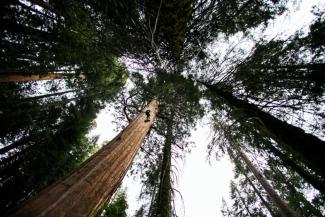
Jared Farmer Los Angeles Times Op-Ed: The Golden State treescape wasn’t made to last. Earthquakes and fires compete as metaphors for contemporary California. While we await the Big One, fire keeps winning the competition. The year 2020, like 2018 before, is the worst on record — until the next worst fire year. When will the burning end? That’s the wrong question. Better to ask: How can Californians learn to live with the absence of an ending?
Earthquakes and fires compete as metaphors for contemporary California. While we await the Big One, fire keeps winning the competition. The year 2020, like 2018 before, is the worst on record — until the next worst fire year. When will the burning end? That’s the wrong question. Better to ask: How can Californians learn to live with the absence of an ending?
To appreciate the magnitude of this moment requires the long view. On the scale of geological time, the Golden State’s 20th century treescape was anomalous. For most of the Holocene, the epoch since the last ice age, California was defined more by wetlands, grasslands and chaparral than by forests. And its forests were more open than dense, thanks in part to intentional burning by Indigenous peoples.
After a triple temblor — U.S. war against Mexico, international mass migration of gold-seekers and genocidal violence by Anglos against Natives — the ecology of California abruptly changed. Afforestation, not deforestation, was a signal achievement of U.S. “improvers.” By draining and damming and diverting, Anglo Americans transformed wetlands and arid plains into fruitful orchards and garden cities. Despite wastefully cutting sugar pine, tanoak and redwood, they also “saved” forest trees through fire suppression. And they planted millions of nonnative agricultural and ornamental trees.
This forced greening benefited from a climatic anomaly. The 100-year interval following the Gold Rush happened to be California’s wettest century in 2,000 years — one more example of the astonishing dumb luck of U.S. history. For plants introduced from Australia, for example, Mediterranean California was like God’s own greenhouse. Even better, the Far West lacked predators and pathogens from Down Under. Throughout the state’s lowlands, eucalyptus trees achieved the stature of millennial sequoias in merely one century.
To read the entire Op-ed - https://www.latimes.com/opinion/story/2020-11-01/california-wildfire-forest-sequoias-eucalyptus-climate-change
